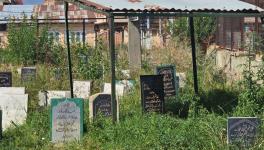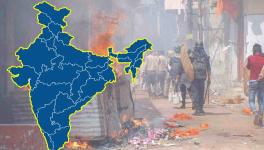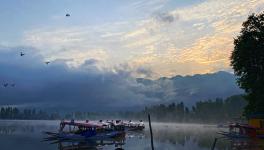Kashmir: Can Traditional Housing Mitigate Quake Damage?
The October 2005 earthquake in Kashmir is remembered as one of the worst natural disasters in South Asia
Over the past 10 weeks, India-administered Kashmir has experienced 17 earthquakes. Five of them registered a magnitude of 4.0 or higher, while 12 ranged between 4.0 and 2.0 on the Richter scale.
On June 13, a 5.2 magnitude earthquake left six people injured in the region's Doda district. Doda lies on the fault line within the collision zone of the Indian and Eurasian tectonic plates, making it highly prone to seismic activity.
Kashmir has a history of devastating earthquakes. On October 8, 2005, a magnitude 7.6 earthquake struck the region, killing more than 80,000 people in both India and Pakistan-administered sections of Kashmir. Scores of buildings were also damaged in the earthquake.
Experts including Ghulam Muhammad Bhat, UNESCO Member of Board of Research on Disaster Management, told DW there is consensus among geologists and seismologists that there is a high likelihood that a magnitude 8 earthquake will hit Kashmir in the near future.
"Stress is building up in the rocks, and cracks indicate the potential for rock dislocation. We cannot rule out the possibility of a magnitude 8 earthquake in Kashmir," Bhat said.
Seismologist Roger Bilham has repeatedly warned that accumulated stress in the region could lead to a 8.2 to 8.4 magnitude earthquake in the Himalayas.
How can Kashmir prepare for a catastrophic earthquake?
Despite the fact that the mountainous region is prone to earthquakes, the government has fallen short in addressing weaknesses in infrastructure and the urgent need for a comprehensive disaster response.
"Dozens of buildings have developed cracks. I am scared of these recurring tremors. They seem to be an ominous sign of an impending catastrophic earthquake," Firdous Khanday, a resident of Doda, told DW.
Experts emphasize the importance of prioritizing resilient infrastructure and construction practices to withstand the visible indicators of stress build-up caused by shifting tectonic plates.
"If a magnitude 8 earthquake were to hit Kashmir today, the devastation would be immense, with structures unable to withstand the force," disaster management expert Bhat warned.
Specialists recommend microseismic zoning andrisk assessments in Kashmir to minimize the loss of human lives in the event of a high-magnitude quake.
"Without microseismic zoning, our master plans for towns and cities are rendered futile," a senior structural engineer working in the region's government told DW.
He said no construction activity should be allowed until microseismic zoning has been conducted.
"Building high-rise structures without considering fault lines directly beneath them puts lives at risk and undermines the purpose of our planning," he said.
"Introducing active and passive dampening systems in all buildings is necessary. Base isolation and shock absorbers can absorb earthquake shocks, reducing excessive horizontal movement and ensuring stability," he added.
Are Kashmir's traditional construction methods the solution?
In wake of the recent earthquakes, Kashmiris are calling for a revamping of their infrastructure systems, or for a return to its traditional construction system known as "Dajji Dewar" to minimize damage during earthquakes.
Dajji Dewar involves using thinner walls with timber framing, combined with bricks or stone masonry, to withstand seismic forces and prevent homes from collapsing.
"Most traditional architecture was resilient to earthquakes. Kashmir has three variants of timber-laced architecture. The presence of flexible timber as a tying element to the rigid masonry is what made these constructions withstand forces of an earthquake," conservation architect Saima Iqbal, told DW.
The shift towards load-bearing masonry and reinforced concrete structures in the 20th century resulted in a decline of timber usage, except for constructing upper floors using the Dhajji Dewari technique.
"Learning from past experiences, it is vital to construct resilient structures that can withstand seismic forces and protect lives. The Dhajji Dewari construction system is well-suited for Kashmir, as it allows for cracks without complete collapse," Iqbal said.
She said local schools and hospitals lack structural audits and emphasized that buildings must be designed with resilience in mind to resist earthquakes.
"Our focus should be on preventing rooftops and slabs from collapsing onto the ground floor, which cause major casualties. The earthquake resistance structures allow for cracks without complete collapse," she said.
Disaster management experts say Kashmir is also in urgent need of a disaster mitigation plan.
"By identifying the most probable collapse areas and gathering building data, we can locate people and expedite debris clearance efforts," said the structural engineer, who requested anonymity.
Following building codes, such as the Indian Standard codes, and applying data science to study downtown areas of Kashmir, where a significant population resides, should enable authorities to develop effective mitigation plans and safeguard lives, he said.
Edited by: Sou-Jie van Brunnersum
Get the latest reports & analysis with people's perspective on Protests, movements & deep analytical videos, discussions of the current affairs in your Telegram app. Subscribe to NewsClick's Telegram channel & get Real-Time updates on stories, as they get published on our website.
























